November 2017; Updated November 2019
The Envelope Pushes Back
We manage to bend our rear axle… again
So what’s the deal with the bent rear axle housing you ask? Well, it does happen, and we know because we’ve managed to do it twice. Our first time was while driving in the US in 2016, and now we’ve done it again here in Western Australia in 2017.
Why is that? It’s simple really. In normal day to day service on reasonable roads very few owners will ever experience a problem with a rear axle, but as soon as you begin to take a vehicle off pavement, normally reliable components are placed under added stress and may fail. Off roaders bend axles on lots of trucks and SUVs; any make of truck can suffer this problem when used in off road conditions.
In the case of our Tiger we are talking about a 2007 Chevrolet Silverado Classic 2500 HD 3/4 ton truck. This truck is identical to an ’06 model but was sold as an ’07 due to a change in diesel engine emission controls that went into effect January 1, 2007.
At the time of this incident in November 2017, our truck had a little under 200,000 miles on the odometer.
The Problem:
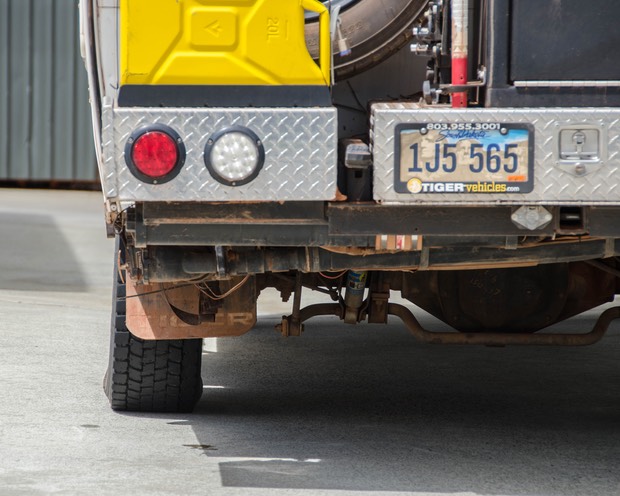
Once you take a vehicle off road the stresses on the running gear increase dramatically. When the axle is over stressed by the rough conditions and other factors, one or the other or both of the axle tubes can bend. When this happens, both rear wheels will lean inward at the top as seen in this photo even if only one tube has bent. This angle of the wheel is called ‘negative camber’ in wheel alignment parlance and should never be seen in a vehicle that has a solid axle as opposed to independent suspension. Seeing this condition on our truck for the second time did not make us happy campers!
GM 2500/3500 trucks from 2001 to 2010 all used basically the same AAM 11.5” rear axle. There’s nothing skimpy about this axle and in normal highway use they are unlikely to give anyone trouble. In fact, this axle is referred to in one magazine article as, “the largest axle ever used in a single rear wheel pickup truck”. The same axle was also used on Dodge trucks from ’03 to ’10 and the basic unit continues to be used on newer GM trucks, which carry heavier load ratings accross the board. I can’t speak for what changes, if any, may have been made in the rear axles to allow the increased load ratings on 2011 and newer models.
All load ratings mentioned below are for 2006 model GM trucks. I will provide links at the end of the article to other articles on this website and also to outside sources that relate to this issue.
The Causes:
Usage: Certainly a variety of things can contribute to this damage occurring but I believe the most important factor is the use of the truck on rough roads. We plead guilty to this, but our defense is that we bought this vehicle to use off pavement, have never tried to baby it, and don’t plan to stop going off pavement in the future. We try not to do anything silly and have never gone out of our way looking for the roughest tracks with which to test either ourselves or our truck. After all, we are carrying our entire household with us so we try very hard to be careful. It’s just that as travelers we enjoy going off the beaten path whenever we can; it’s what we do. We have always felt strongly that this is a great truck, but as with any machine, it has its limitations and we continue to learn what they are. We’ve been pushing envelopes with our Tiger for over ten years and maybe some of them shouldn’t be pushed quite so hard.
In our own defense, the damage under discussion occurred at low speed while driving in sand conditions, when we came over a slight rise and down into a bit of a hole that I couldn’t see. We were not going fast, no more than 10 mph if that; just maintaining momentum in lo-range 4wd, but it was enough.
So if we don’t want to change our usage of the vehicle, what other things that may have contributed to the problem can we try to address in order to effect a long term repair? In discussion with our repair partners both in the US and here in Australia, we identified three mechanical factors that we planned to address during the repair process.
Weight: The first is that, as this photo may cause you to think, we are probably carrying too much weight on the rear axle.
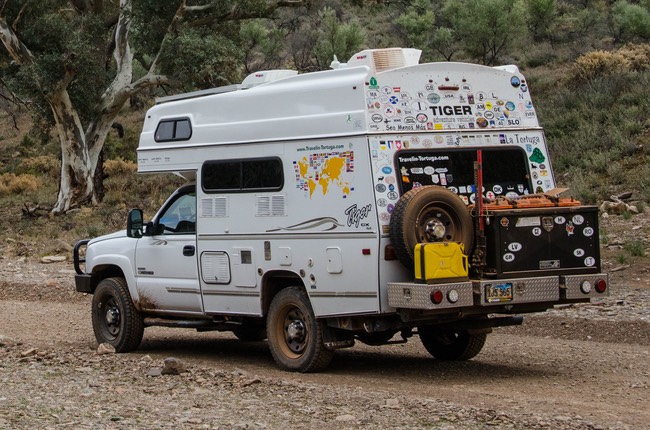
This may well be the case. However, it is really difficult to know for sure because, as mentioned above, the same rear axle is used in both the 2500 HD and 3500 Single Rear Wheel trucks and, with only one modification, in the 3500 dual wheel truck as well. In the 2500 & 3500 SRW the rear axle has a load rating of 6,084 and 6,500 lbs respectively, with the variation in rating between the two models resulting from the larger tire size and one added leaf in the spring packs on the 3500; not a difference in the actual axle. This is not just supposition, the slightly odd 6,084 rating on the rear axle in the 2500 HD represents the load rating (3,042 lbs) of the standard tire size (245x75) times two. Since we upgraded the tire size early on and have added to the stock spring pack, our truck is in effect a 3500, so I’ve always felt comfortable using the higher weight rating as my guide.
For the 3500 Dual Rear Wheel truck the rear axle rating jumps to 8,550 lbs, but once again it is difficult to say how much of this is due to the increased tire load capacity and heavier springs and how much to changes in the axle itself. I say this because the only difference between the axles for the SRW and DRW is an increase in the diameter of the axle tubes. Both axles have the same differential, same bearings on both ends, same brakes, everything. For the 2500/3500 SRW the axle tubes are 4” diameter at both ends but taper to 3.5” for most of their length, while on the 3500 DRW they stay 4” for their entire length; in both cases the tubes are made of 1/4” steel.
I’m not an engineer, but after seeking the advice of friends who are, it seems that this seemingly minor change in the diameter of the axle tubes is actually pretty significant. Apparently the larger diameter increases the strength of the tubes by around 50%, which is certainly a noticeable improvement that can, in conjuction with the dual wheels and heavier springs, account for the increase in load rating for this axle. With this much improvement from the larger tubes I certainly now feel that we should have gone to the added cost and time delay to locate a 3500 DRW axle when we suffered our first bending incident in 2016.
We will discuss specifics of our truck’s weight later in this article, but in summary we have weighed our truck a number of times over the years and have generally weighed in at between 10,000 and 10,200 lbs, with about 6,200 lbs on the rear axle. It had been several years since the last weighing, so after the most recent bending incident we weighed it again and found that overall weight was up to 11,000 lbs and we were now carrying 6,950 lbs on the rear. This increase naturally concerned me, but after some thought I found that I could identify virtually all of the weight gain. We’ll return to the causes of the gain and an update on the weight after repairs later.
Spacers: Our second likely stress factor is the use of wheel spacers. Like some other Tigers, ours came with 2-1/2” aluminum spacers on the rear axle to move the rear wheels further outward. These were a standard factory option at the time ours was built (they were already installed the first time we saw the truck) and are for appearance only as the Tiger’s body is about 8” wider than the normal pickup truck bed. In retrospect I should have removed the spacers after our first bent axle incident in 2016 if not much earlier. I didn’t because repair people don’t seem to agree on the effect this particular item may or may not have on the rear axle. While it is logical that moving the wheels outward will increase the leverage of the wheels and thus increase the stress on the axle tubes, opinions seem to split about 50/50 on how much difference it makes and therefore on the importance of removing the spacers.
Wheels & Tires: The third factor to be receiving attention this time is the much heavier wheels and tires we have been running. In our first four years of driving the Tiger we broke two sets of wheels; first the factory steel wheels and then a set of aftermarket aluminum wheels. These failures led us to the decision to switch to heavy duty 19.5” Rickson steel wheels and truck tires in 2012. These have worked well for us, but a major downside of this change in light of the current discussion is that the larger wheels and tires add 60 lbs per wheel/tire assembly to the truck; 300 lbs total. If we limit the discussion to the rear axle only, that’s 180 lbs of the total axle weight — including the spare. And, 120 lbs of that 180 lbs is unsprung weight acting on the ends of the axle tubes through the added leverage of the wheel spacers. Something to be concerned about? I believe so.
The more I consider each of these variables, the more I think that when combined with the way we use the truck, the spacers and the heavy wheels and tires may turn out to be the most important factors. I say this because these are the constants between our two bending incidents in 2016 and again in 2017. The 2016 incident predated the installation of the recovery gear (discussed below) with its attendent added weight, and the spare tire was still being carried on the front. At that time, the weight on the rear axle was certainly below the 6500 lb rating given for this axle on the 3500 SRW model; yet we still managed to bend the axle.
The Solutions:
When the axle bent the first time, in 2016, we looked hard at upgrading to a 3500 axle. When we learned how little difference there is between them we chose to simply source a used ’07 2500 HD unit in hopes it would hold up as long as the first one had, or that the first failure had been some sort of fluke event. This proved to be a poor decision, so when the same problem happened again I wanted no part of just finding another axle and starting over. I wanted the axle fixed and strengthened and the other causal factors addressed as much as possible. Otherwise we would have had to dramatically change our travel plans to curtail rough road travel and we didn’t want to do that.
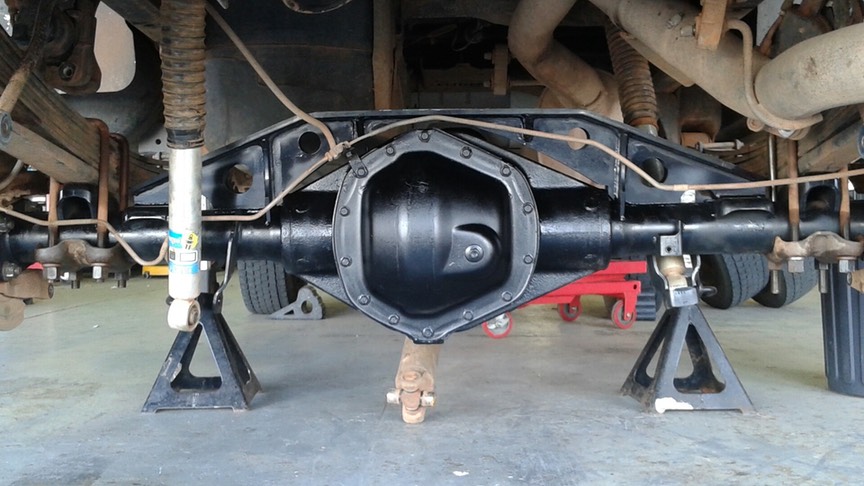
Strengthen the Axle: With help from our friend at RPM Diesel in Oregon, we located a support truss designed for this axle in the US and had it shipped here to Perth. The fact that someone is making an aftermarket truss tells us that we are not alone in experiencing this problem. If you follow the link below to the Artec website (the maker of the truss), you'll see that they also make trusses for axles used by other manufacturers.
Once the truss arrived we had the axle taken out for straightening and installation of the truss, which must be welded on to the axle tubes. This is a relatively straightforward process, but does require the appropriate welding equipment and experience. The truss comes in pieces and must be welded together as well as being welded to the axle. This did not present any difficulty to the shop doing the work, but it is not a simple bolt on item.
The truss is a substantial piece and should go a long way toward eliminating the problem; it might even have been enough all by itself. In an effort to be sure of a fix, however, we are also attacking each of the areas we identified as probable contributing factors: weight, wheel spacers, and heavy wheels and tires.
Spacers: Taking the easiest item first, we eliminated the wheel spacers all together, thus moving the wheel centerline in toward the center of the axle and lessening the leverage of the forces being applied to the axle tubes.
Wheels & Tires: We’ve also abandoned the 19.5” Rickson wheels and truck tires. These wheels are a terrific, high quality product and they did everything we expected of them. However, given our concerns about weight and our use of the truck on rough roads, I felt that the requirement of running truck tires, which I had never been completely happy with, along with the significant weight disadvantage when compared to 16” aluminum wheels with Light Truck tires, was something I no longer wanted to have to deal with.
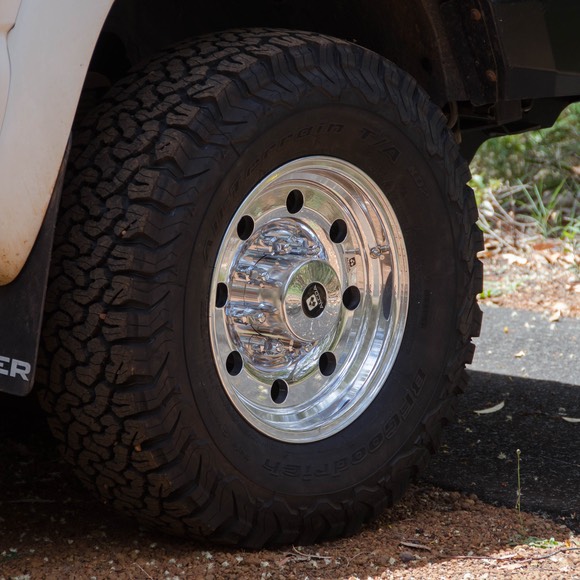
Our experience in having to replace wheels has shown us that finding wheels that are strong enough to deal with the weight of our Tiger together with the rough roads we regularly encounter is a challenge. With this in mind I selected an Alcoa wheel. Alcoa wheels are forged aluminum rather than cast, and they make them for the trucking industry and also the RV industry in the US. These wheels not only have a reputation for durability, but we owned a US motorhome for eleven years that used them. Postive feedback from others, supported by our personal experience, gave me confidence that I could trust these wheels and trust Alcoa’s load rating of them.
Alcoa’s model 167041 Classic 8 wheel, which is still in current production, is a 16” x 7” wheel (same size as stock) with the 8 lug x 6.5” bolt circle that was used by GM up through the 2010 model year. This wheel is rated at 3,750 lbs and can carry up to a 265x75 tire, which has a load rating of 3,415 lbs (Load Range E, with a 123 rating). Larger tire sizes with higher load ratings require a wider wheel. The combination of the Alcoa wheels and 265/75R16 tires weigh in at under 75 lbs, down from the Rickson wheels with 245/70R19.5 tires combined weight of 135 lbs. Only time will tell if the Alcoa wheels will be the answer, but for now I feel good about the change. As of November 2019 we’ve put 40,000 miles on these wheels with no problems of any kind
Weight Reduction: That leaves the biggest challenge, finding ways to reduce the overall weight of the vehicle and especially the amount of weight carried on the rear axle. Our goals here were first to reduce overall weight wherever we could and second to move weight forward in the truck as much as possible.
Our largest opportunity to reduce overall weight was to replace the heavy wheels and tires, as explained above. After more than ten years of near full time travel in this vehicle, Kathy and I are not carrying around any dead weight items that are not necessary. We are long past the point of having anything in the truck that is not used often enough to justify the space and weight it represents. As a result, we didn’t find many items in the living area that we were interested in parting with. We did put together a box of travel books and maps that we shipped back to where our car is being stored, gave away some other books, and also gave up on carrying the small barbecue we seldom use, but that’s about all.
Most of our efforts therefore centered on finding ways to move weight forward and in this we were more successful than I’d anticipated. We have a standard cab truck, not an extended cab, so our options here are somewhat limited. With little storage available in the cab and only a small exterior storage compartment built into the Tiger’s design, we have always needed additional storage boxes mounted on the rear of the vehicle. Over our years of travel we’ve gradually reduced the number of items that we feel the need to carry, but still we have tools, a hydraulic jack, a few spare parts, lubricants and sealants, hoses, an air compressor, macerator pump and a pair of camp chairs, but that’s about it.
Before shipping to Australia we felt that we needed to improve our capabilities in the area of recovery gear so we installed a bull bar front bumper with winch, a high lift jack with accessories, tow straps and shackles, a pair of sand tracks and also a pair of jerry cans for fuel or water.
The point here is not to discuss the merits of any of these items, but merely to point out that, with the exception of the front bumper and winch, the other things have been either carried in or mounted on the storage boxes located on the rear of the truck. Thus their weight not only rests on the rear axle, but the effect of that weight is magnified by their location several feet behind it.
What to do?
I was pleasantly surprised to find that with careful packing I could move many of these items up front behind and under the front seats. I have no scale to weigh the items in order to calculate the total weight, but I was able to shift the location of all the heaviest things, including both the high lift jack, which moved to the front bumper, and also the four ton hydraulic bottle jack I carry, as well as shackles, pulleys, tow straps and other odds and ends, all of which found locations behind the cab seats. The only recovery gear remaining on the rear are the usually empty jerry cans, Maxtrax sand tracks and a shovel.
So how did all of this effect the weight of the truck? First off, as anyone who has weighed an RV before knows, there are significant variables to be considered in terms of the amount of fuel, fresh water and holding tank contents being carried. We try to standardize these levels when weighing, but there will always be variations.
For reference, our most recent weight before shipping to Australia was done in Germany in 2011 — this was prior to the installation of the heavier 19.5” wheels and tires. At that time our overall weight was 4,560 kilograms, or 10,032 lbs. We carried 6,226 lbs on the rear and 3,806 lbs on the front. This was similar to other weights we’d taken over the years and forms the baseline weight of the Tiger pre wheel change and Australia prep.
After discovering the bent axle, we weighed the truck when we arrived in Perth. Our weight then was 5,010 kgs, or 11,020 lbs, with 6,950 lbs on the rear and 4,070 lbs on the front; an increase of almost 1,000 lbs overall with more than 700 lbs of that on the rear axle. Ouch!
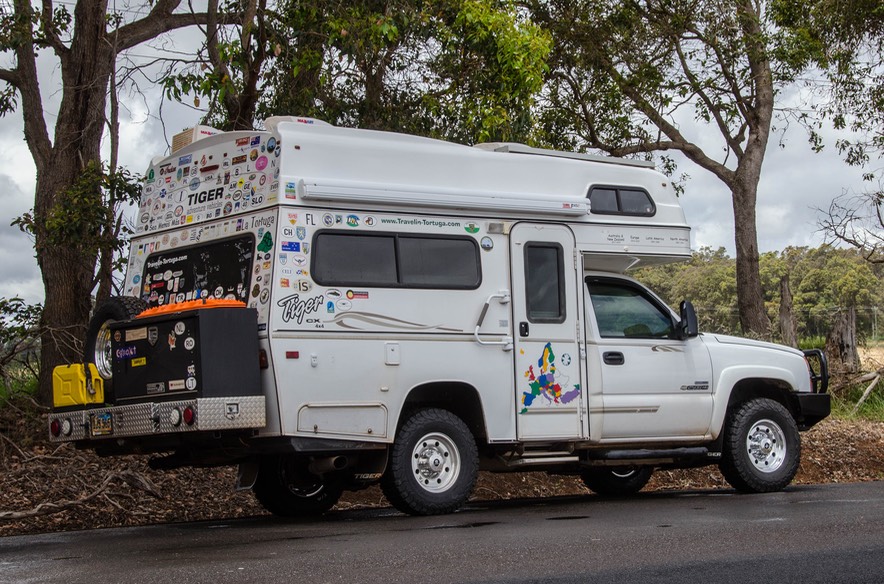
What did we do to gain so much weight? In 2012 we switched to the 19.5” wheels and tires. As noted above, that change accounts for 300 lbs of the total increase with 60% of that on the rear because that’s where the spare wheel is now carried (it used to be up front). Then in 2016 we added the front bumper and winch on the front of the truck, adding roughly another 300 lbs — this is the reason we moved the spare. We also increased our battery bank and solar capacity, adding one panel and two batteries — that's another 200 lbs. Add in the assorted recovery gear listed above and we’ve accounted for pretty much all of our weight gain. Figuring this out was a huge relief to me in that at least I could explain the increase and knew we hadn’t just gotten careless. But it it still left the added weight to be dealt with.
After completing the repairs, changing the wheels and tires and shifting weight forward, we weighed the truck again. This time our overall weight was down to 4,770 kgs, or 10,494 lbs, with 6,380 lbs on the rear and 4,114 lbs on the front. This is a reduction of 526 lbs overall, but more importantly, all of the reduction came by lessening the weight on the rear axle; this despite the added 50 lb weight of the truss. The front axle weight increased by 44 lbs after the changes, but actually, we managed to add 164 lbs to the front end as a result of our efforts; this because the weight increased despite the 120 lbs reduction caused by replacing the two front wheels. I consider this to be a major success and a noticeable improvement in our circumstances. The percentage of weight being carried on the rear dropped from 63% to under 61%.
Conclusions:
Time will tell whether this problem is forever behind us, but I think it is. We’ve not only strenghened the axle housing, but reduced or eliminated each of the factors we had identified as contributing causes of the damage. The return to the lighter wheels and LT tires has, as expected, improved the ride and handling of the truck and will greatly enhance performance in rough or sandy conditions as a result of the LT tires' much improved abilities in these areas when compared to the truck tires.
Having completed this project, we now feel that we can press on with our travels believing that despite the costs in time and money incurred in making these changes, we have improved our vehicle in significant ways. Vive La Tortuga!
Links:
Article on this site discussing What’s Gone Wrong with our vehicle - covers the wheel breakage in detail
Article on this site about the change to Rickson Wheels - includes information on the switch to truck tires
Article on this site about Our Vehicle - gives general background on our Tiger
Magazine article on beefing up the axle assembly: https://www.dieselworldmag.com/ultimate-rear-axle-build-a-super-strong-11-5-aam-rear-end-for-your-gm-or-dodge-part-1/
Second magazine article for reference: http://www.trucktrend.com/how-to/transmission-drivetrain/1205dp-rebuilding-an-01-to-10-gm-rear-axle/
The truss we got: http://www.artecindustries.com/AAM-115-Rear-Truss_p_298.html
Repair Partners:
In Grant’s Pass, Oregon, USA - RPM Diesel, Grants Pass, Oregon, USA
In Perth, Australia - performancewest.com.au (sadly now closed as of 11/18)